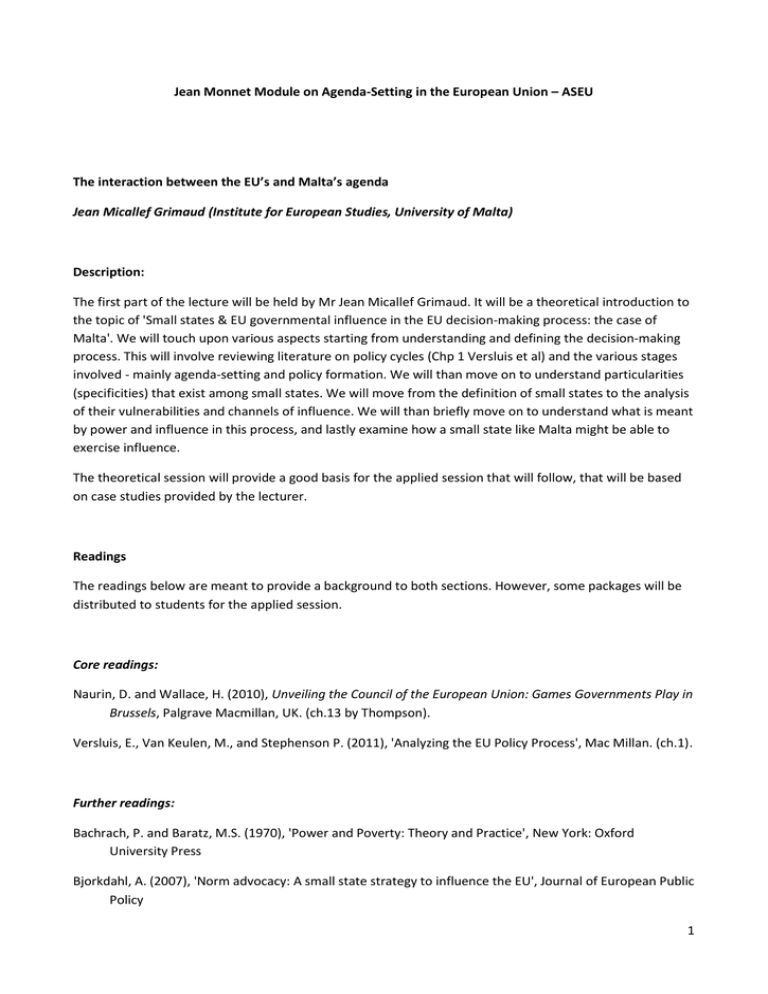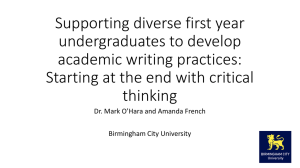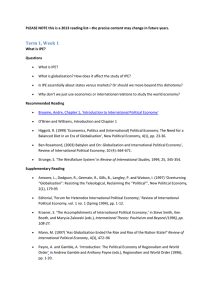Jean Monnet Module on Agenda-Setting in the European Union –... The interaction between the EU’s and Malta’s agenda
advertisement

Jean Monnet Module on Agenda-Setting in the European Union – ASEU The interaction between the EU’s and Malta’s agenda Jean Micallef Grimaud (Institute for European Studies, University of Malta) Description: The first part of the lecture will be held by Mr Jean Micallef Grimaud. It will be a theoretical introduction to the topic of 'Small states & EU governmental influence in the EU decision-making process: the case of Malta'. We will touch upon various aspects starting from understanding and defining the decision-making process. This will involve reviewing literature on policy cycles (Chp 1 Versluis et al) and the various stages involved - mainly agenda-setting and policy formation. We will than move on to understand particularities (specificities) that exist among small states. We will move from the definition of small states to the analysis of their vulnerabilities and channels of influence. We will than briefly move on to understand what is meant by power and influence in this process, and lastly examine how a small state like Malta might be able to exercise influence. The theoretical session will provide a good basis for the applied session that will follow, that will be based on case studies provided by the lecturer. Readings The readings below are meant to provide a background to both sections. However, some packages will be distributed to students for the applied session. Core readings: Naurin, D. and Wallace, H. (2010), Unveiling the Council of the European Union: Games Governments Play in Brussels, Palgrave Macmillan, UK. (ch.13 by Thompson). Versluis, E., Van Keulen, M., and Stephenson P. (2011), 'Analyzing the EU Policy Process', Mac Millan. (ch.1). Further readings: Bachrach, P. and Baratz, M.S. (1970), 'Power and Poverty: Theory and Practice', New York: Oxford University Press Bjorkdahl, A. (2007), 'Norm advocacy: A small state strategy to influence the EU', Journal of European Public Policy 1 Borzel, T. A. (2002), 'Pace-setting, foot-dragging, and fence-sitting: Member State response to Europeanization',Journal of Common Market Studies, Vol.40 (2) Bunse, S. (2009), 'Small States and EU Governance: Leadership through the Council Presidency', Palgrave Macmillan, UK, p. 8. Dahl, R. A. (1957), 'The Concept of Power', Behavioral Science, 2:201-15; reprinted in Scott, J. (1994), 'Power: Critical Concepts', 3 vols. London: Routledge. Haverland, M. (2009), 'How leader states influence EU policy-making: Analysing the expert strategy', European Integration online Papers (EIoP), Vol. 13, Art. 25, http:eiop.or.ateioptexte2009-025a.htm. Jachtenfuchs, M. and Kohler-Koch, B. (1995), 'The Transformation of Governance in the European Union', paper presented at the Fourth Biennial Conference of the European Community Studies Association, Charleston, SC. Liefferink, D. and Skou-Andersen, M. (1998b), 'Strategies of the 'green' member states in EU environmentalpolicy-making', Journal of European Public Policy, Vol. 5(2 Lukes, S. (2005), 'Power: A Radical View', 2^nd edn., Palgrave Macmillan. March, J.G. and Olsen, J.P. (2005), 'Elaborating the "New Institutionalism"', Arena Working Paper, 11, Naurin, D. and Wallace, H. (eds) (2010), 'Unveiling the Council of the European Union. Game Governments Play in Brussels', Houndsmills Basingstoke: Palgrave Macmillan. Schattschneider, E.E. (1957), 'Intensity, Visibility, Direction and Scope', American Political Science Review, Vol. 51(4) Tallberg, J. (2008), 'Bargaining Power in the European Council', Journal of Common Market Studies (JCMS), Vol. 46(3) 2

